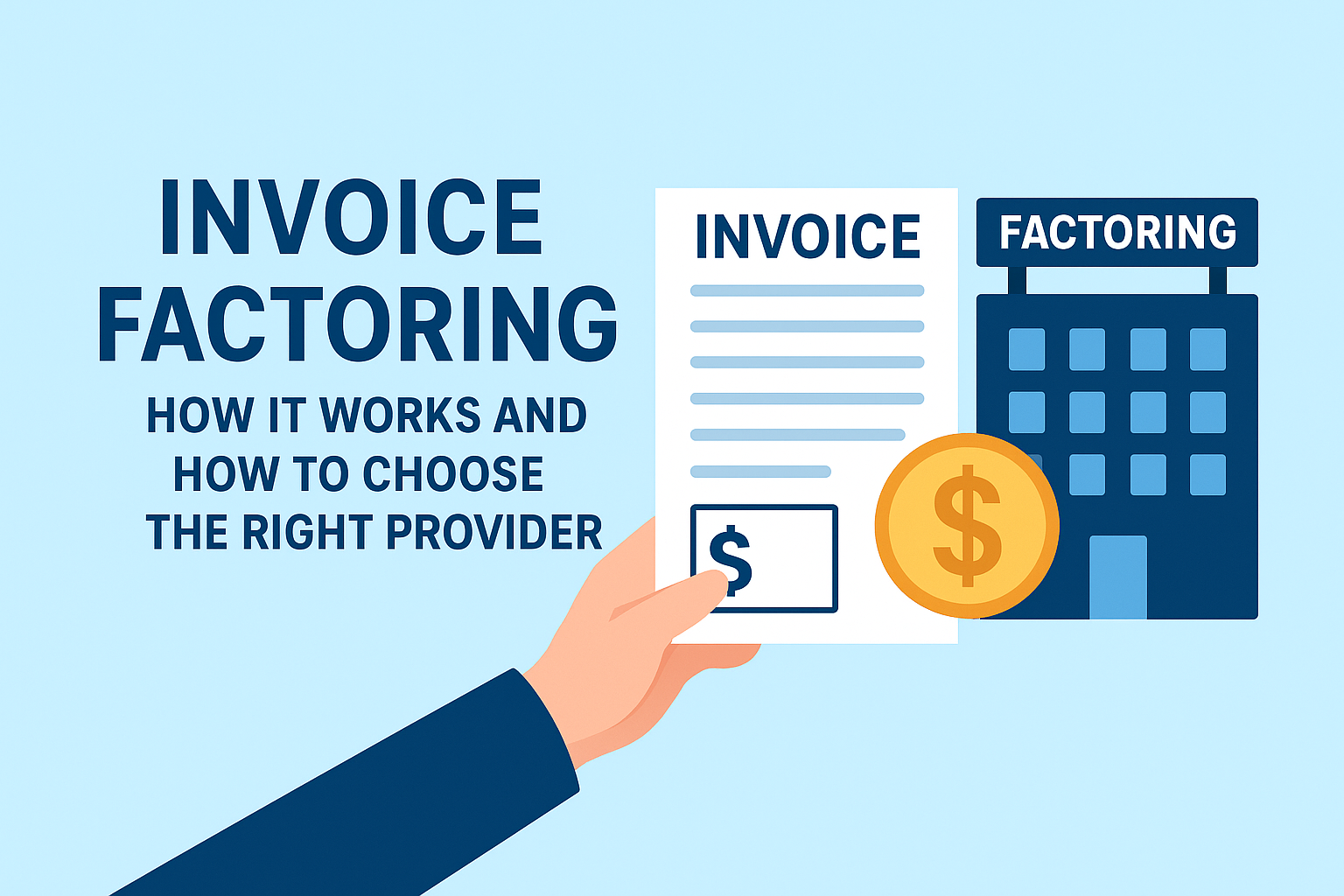Invoice Factoring: How It Works and How to Choose the Right Provider
What Is Invoice Factoring?
Invoice factoring lets you convert unpaid invoices into immediate cash by selling them to a factoring company. Instead of waiting 30, 60, or 90 days for customers to pay, you sell the invoices at a discount. The factor advances most of the invoice value upfront, collects payment from the customer, then returns the remainder to you — minus their fee.
How Invoice Factoring Works
The following step-by-step description explains the standard flow:
Step 1 — You generate the invoice
Deliver the product or service and issue an invoice (for example, $10,000) with payment terms (Net 30/60).
Step 2 — Sell the invoice to a factoring company
Assign the invoice to the factor. They perform a credit check on your customer, since the debtor’s ability to pay determines risk.
Step 3 — Receive an advance
The factor advances a portion of the invoice (commonly 70%–95%), so you get immediate cash to run operations.
Step 4 — Customer pays the factor
The customer pays the invoice directly to the factor (notification) or continues paying you while the factor remains behind the scenes (non-notification), depending on the agreement.
Step 5 — Remainder released minus fees
When the invoice is collected, the factor pays you the remaining balance minus the factoring fee.
| Invoice Value | Advance Rate | Fee | Total You Receive |
|---|---|---|---|
| $10,000 | 85% | 3% (30 days) | $9,700 |
| $10,000 | 80% | 4% (45 days) | $9,600 |
| $20,000 | 90% | 2% (20 days) | $19,600 |
Types of Invoice Factoring
Recourse vs Non-recourse
Recourse factoring requires you to buy back invoices or reimburse the factor if the customer doesn’t pay. Non-recourse factoring shifts most of the non-payment risk to the factor, but typically costs more and may have exclusions.
Spot vs Whole-ledger
Spot factoring is used for single invoices. Whole-ledger factoring covers most or all invoices and usually secures better pricing.
Notification vs Non-notification
Notification factoring informs your customer to pay the factor directly. Non-notification keeps the arrangement confidential, preserving customer relationships.
How Much Does Invoice Factoring Cost?
Factoring fees commonly range from 1%–5% per 30 days of the invoice value. Key cost drivers include invoice size, customer credit, industry risk, and payment timelines.
| Driver | Effect on Cost |
|---|---|
| Invoice size | Larger invoices often lower percentage cost |
| Payment terms | Longer terms increase fees |
| Customer credit | Weaker credit → higher fees |
| Volume | Higher volume → negotiating power → lower fees |
Pros & Cons
Pros
- Immediate improvement to cash flow
- No new long-term debt on your balance sheet
- Factor often handles collections and credit control
Cons
- Effective cost can be higher than traditional loans
- Customers may learn a third party is involved (if notification)
- Contracts sometimes have minimums or hidden fees — read carefully
Invoice Factoring vs Alternatives
| Option | Speed | Typical Cost | Best For |
|---|---|---|---|
| Invoice Factoring | 1–3 days | 1–5% per 30 days | Fast access to receivables |
| Invoice Financing | 2–5 days | Interest 2–4% monthly | Keep control of collections |
| Line of Credit | 5–10 days | 10–25% APR | Ongoing working capital |
| Merchant Cash Advance | 1–2 days | Very high effective cost | Retailers with strong card sales |
Industry Examples & Use-Cases
Trucking: Bridge fuel and payroll while waiting for broker payments. Staffing: Pay staff weekly while clients pay monthly. Manufacturing: Buy materials before customer invoices are paid.
Mini Case Study
ABC Logistics factored $150,000 of 45-day receivables at an 85% advance and a 3% fee. They received $127,500 immediately, enabling them to accept a larger contract and grow revenue.
How to Choose a Factoring Company
Ask these six critical questions when you evaluate providers:
- What is the advance rate and total fee structure?
- Is the agreement recourse or non-recourse?
- Are there setup, wire, or minimum-volume fees?
- How quickly will I be funded?
- Will customers be notified?
- How easily can I exit the contract?
Checklist: transparent pricing, fast funding, industry experience, positive reviews, simple contract terms, responsive support.
Invoice Factoring Calculator
Use this simple calculator to estimate the cash you’ll receive after factoring fees.
Frequently Asked Questions
What is invoice factoring and how does it work?
Invoice factoring is when a business sells its unpaid invoices to a factoring company in exchange for immediate cash. The factor collects payment from customers later and returns the remaining balance to you after fees.
How much does invoice factoring cost?
Typically 1%–5% of invoice value per 30 days. Costs depend on customer creditworthiness, invoice age, industry, and volume.
Recourse vs non-recourse: which is safer?
Non-recourse is safer because the factor assumes most non-payment risk, but it comes at a higher cost. Recourse factoring is cheaper but exposes you to repayment obligations if customers fail to pay.
How quickly can I get funded?
Many factoring companies fund within 24–48 hours after invoice verification and debtor credit approval.
Conclusion
Invoice factoring can be a reliable short-term liquidity tool for businesses with slow-paying B2B customers. Use the calculator to understand the real cost, compare multiple offers, and choose a provider with transparent terms and industry experience.
About the Author
Abhishek Kandir is a financial writer and founder of Paisewaise.com. He helps small-business owners and investors make clearer, more profitable finance decisions by translating complex topics into practical steps.
Published by Paisewaise • Privacy

Owner of Paisewaise
I’m a friendly finance expert who helps people manage money wisely. I explain budgeting, earning, and investing in a clear, easy-to-understand way.

